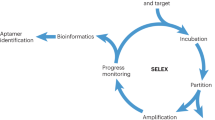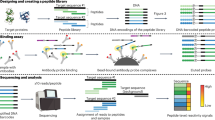Abstract
The recent development of in vitro methods to select high-affinity ligands by combinatorial chemistry methodologies promises unique and theoretically unlimited supplies of novel therapeutic and diagnostic reagents. One such combinatorial chemistry process, systematic evolution of ligands by exponential enrichment (SELEX), allows rapid identification, from large random sequence pools, of the few oligonucleotide sequences that bind to a desired target molecule with high affinity and specificity. We describe an enzyme-linked sandwich assay that uses a SELEX-derived oligonucleotide. This assay demonstrates that these oligonucleotides can be effective and useful analytical reagents.
This is a preview of subscription content, access via your institution
Access options
Subscribe to this journal
Receive 12 print issues and online access
$209.00 per year
only $17.42 per issue
Buy this article
- Purchase on Springer Link
- Instant access to full article PDF
Prices may be subject to local taxes which are calculated during checkout
Similar content being viewed by others
References
Yalow, R.S. and Berson, S.A. 1959. Assay of plasma insulin in human subjects by immunological methods. Nature 184: 1648–1649.
Engvall, E. and Perlmann, P. 1971. Enzyme-linked immunosorbent assay (ELISA) quantitative assay of immunoglobulin G. Immunochem. 8: 871–874.
Crowther, J.R. (ed.). 1995. ELISA theory and practice, in Methods in molecular biology. Humana Press Inc., Totowa, NJ.
Burgess, G.W. (ed.). 1988. ELISA technology in diagnosis and research. Graduate School of Tropical Veterinary Science, James Cook University of North Queensland, Townsville, Australia.
Riter, M.A. and Ladyman, H.M. (eds.). 1995. Monoclonal antibodies. Cambridge University Press, New York, NY.
Abraham, R., Buxbaum, S., Link, J., Smith, R., Venti, C., and Darsley, M. 1995. Screening and kinetic analysis of recombinant anti-CEA antibody fragments. J. Immunol. Methods 183: 119–125.
Gallop, M.A., Barrett, R.W., Dower, W.J., Fodor, S.P.A., and Gordon, E.M. 1994. Applications of combinatorial technologies to drug discovery. 1. Background and peptide combinatorial libraries. J. Med. Chem. 37: 1233–1251.
Gordon, E.M., Barrett, R.W., Dower, W.J., Fodor, S.P.A., and Gallop, M.A. 1993. Applications of combinatorial technologies to drug discovery. 2. Combinatorial organic synthesis, library screening strategies, and future directions. J. Med. Chem. 37: 1385–1401.
Abelson, J. 1990. Directed evolution of nucleic acids by independent replication and selection. Science 249: 488–489.
Tuerk, C. and Gold, L. 1990. Systematic evolution of ligands by exponential enrichment: RNA ligands to bacteriophage T4 DNA polymerase. Science 249: 505–510.
Irvine, D., Tuerk, C., and Gold, L. 1991. SELEXION, systematic evolution of ligands by exponential enrichment with integrated optimization by non-linear analysis. J. Mol. Biol. 222: 739–761.
Gold, L. 1995. Oligonucleotides as research, diagnostic, and therapeutic agents. J. Biol. Chem. 270: 13581–13584.
Gold, L., Polisky, B., Uhlenbeck, O., and Yarus, M. 1995. Diversity of oligonu-cleotide functions. Annu. Rev. Biochem. 64: 763–797.
Ellington, A.D. 1994. Aptamers achieve the desired recognition. Current Biology 4: 427–429.
Tuerk, C., MacDougal, S., and Gold, L. 1992. RNA pseudoknots that inhibit human immunodeficiency virus type 1 reverse transcriptase. Proc. Natl. Acad. Sci. USA 89: 6988–6992.
Jellinek, D., Lynott, C.K., Rifkin, D.B., and Janjic, N. 1993. High-affinity RNA ligands to basic fibroblast growth factor inhibit receptor binding. Proc. Natl. Acad. Sci. USA 90: 11227–11231.
Jellinek, D., Green, L.S., Bell, C., and Janjic, N. 1994. Inhibition of receptor binding by high-affinity RNA ligands to vascular endothelial growth factor. Biochemistry 33: 10450–10456.
Doudna, J.A., Cech, T.R., and Sullenger, B.A. 1995. Selection of an RNA molecule that mimics a major autoantigenic epitope of human insulin receptor. Biochemistry 92: 2355–2359.
Bock, L.C., Griffin, L.C., Latham, J.A., Vermaas, E.H., and Toole, J.J. 1992. Selection of single-stranded DNA molecules that bind and inhibit human thrombin. Nature 355: 564–566.
Kubik, M.F., Stevens, A.W., Schneider, D., Marlar, R.A., and Tassett, D. 1994. High-affinity RNA ligands to human α-thrombin. Nucleic Acids Res. 22: 2619–2626.
Lin, Y., Qiu, Q., Gill, S.C., and Jayasena, S.D. 1994. Modified RNA sequence pools for in vitro selection. Nucleic Acids Res. 22: 5229–5234.
Nieuwlandt, D., Wecker, M., and Gold, L. 1995. In vitro selection of RNA ligands to substance P. Biochemistry 34: 5651–5659.
Ellington, A.D. and Szostak, J.W. 1990. In vitro selection of RNA molecules that bind specific ligands. Nature 346: 818–822.
Ellington, A.D. and Szostak, J.W. 1992. Selection in vitro of single-stranded DNA molecules that fold into specific ligand-binding structures. Nature 355: 850–852.
Famulok, M. and Szostak, J. 1992. Stereospecific recognition of tryptophan agarose by in vitro selected RNA. J. Am. Chem. Soc. 114: 3990–3991.
Famulok, M. 1994. Molecular recognition of amino acids by RNA-aptamers: An L-citrulline binding RNA motif and its evolution into an L-arginine binder. J. Am. Chem. Soc. 116: 1698–1706.
Connell, G.J., Illangesekare, M., and Yarus, M. 1993. Three small ribooligonu-cleotides with specific arginine sites. Biochemistry 32: 5497–5502.
Sassanfar, M., and Szostak, J. 1993. An RNA motif that binds ATP. Nature 364: 550–553.
Conell, G.J. and Yarus, M. 1994. RNAs with dual specificity and dual RNAs with similar specificity. Science 264: 1137–1141.
Jenison, R.D., Gill, S.C., Pardi, A., and Polisky, B. 1994. High-resolution molecular discrimination by RNA. Science 263: 1425–1429.
McGown, L.B., Joseph, M.J., Pitner, J.B., Vonk, G.P., and Linn, C.P. 1995. The nucleic acid ligand: A new tool for molecular recognition. Analytical Chemistry 67: 663A–668A.
Claffey, K.P., Wilkison, W.O., and Spiegelman, B.M. 1992. Vascular endothelial growth factor regulation by cell differentiation and activated second messenger pathways. J. Biol. Chem. 267: 16317–16322.
Leung, D.W., Cachianes, G., Kuang, W.-J., Goeddel, D.V., and Ferrara, N. 1989. Vascular endothelial growth factor is a secreted angiogenic mitogen. Science 246: 1306–1309.
Tischer, E., Mitchell, R., Hartman, T., Silva, M., Gospodarowicz, D., Fiddes, J.C., et al. 1991. The human gene for vascular endothelial growth factor. J. Biol. Chem. 266: 11947–11954.
Park, J., Keller, G.-A., and Ferrara, N. The vascular endothelial growth factor (VEGF) isoforms: differential deposition into the subepithelial extracellular matrix and bioactivity of extracellular matrix-bound VEGF. 1993. Mol. Biol. Cell 4: 1317–1326.
Houck, K.A., Leung, D.W., Rowland, A.M., Winer, J., and Ferrara, N. 1992. Dual regulation of vascular endothelial growth factor bioavailability by genetic and proteolytic mechanisms. J. Biol. Chem. 267: 26031–26037.
Keck, P.J., Hauser, S.D., Krivi, G., Sanzo, K., Warren, T., Feder, J., and Connolly, D.T. 1989. Vascular permeability factor, an endothelial cell mitogen related to PDGF. Science 246: 1309–1312.
Plouët, J., Schiling, J., and Gospodarowicz, D. 1989. Isolation and characterization of a newly identified endothelial cell mitogen produced by AtT-20 cells. EMBO J. 8: 3801–3806.
Wilting, J., Christ, B., and Welch, H.A. 1992. The effects of growth factors on the day 13 chorioallantoic membrane (CAM): a study of VEGF165 and PDGF-BB. Anat. Embryol. 186: 251–257.
Klagsbrun, M. and D'Amore, P.A. 1991. Regulators of angiogenesis. Annu. Rev. Physiol. 53: 217–239.
Kim, K.J., Li, B., Winer, J., Armanini, M., Gillett, N., Phillips, H.S., et al. 1993. Inhibition of vascular endothelial growth factor-induced angiogenesis suppresses tumour growth in vivo. Nature 362: 841–844.
Kondo, S., Asano, M., and Suzuki, H. 1993. Significance of vascular endothelial growth factor/vascular permeability factor for solid tumor growth, and its inhibition by the antibody. Biochem. Biophys. Res. Commun. 194: 1234–1241.
Kondo, S., Asano, M., Matsuo, K., Ohmori, I., and Suzuki, H. 1994. Vascular endothelial growth factor/vascular permeability factor is detectable in the sera of tumor-bearing mice and cancer patients. Biochimica et Biophysica Acta 1221: 211–214.
Yeo, K.-T., Wang, H.H., Nagy, J.A., Sioussat, T.M., Ledbetter, S.R., Hoogewerf, A.J., et al. 1993. Vascular permeability factor (vascular endothelial growth factor) in guinea pig and human tumor inflammatory effusions. Cancer Research 53: 2912–2918.
Pieken, W.A., Olsen, D.B., Benseler, F., Aurup, H., and Eckstein, F. 1991. Kinetic characterization of ribonuclease-resistant 2′-modified hammerhead ribozymes. Science 253: 314–317.
Jellinek, D., Green, L.S., Bell, C., Lynott, C.K., Gill, N., Vargeese, C., et al. 1995. Potent 2′-amino-2′-deoxypyrimidine RNA inhibitors of basic fibroblast growth factor. Biochemistry 34: 11363–11372.
Green, L.S., Jellinek, D., Bell, C., Beebe, L.A., Feistner, B.D., Gill, S.C., Jucker, F.M., and Janjic, N. 1995. Nuclease resistant nucleic acid ligands to vascular permeability factor/vascular endothelial growth factor. Chemistry and Biology 2: 683–695.
Jensen, K.B., Atkinson, B.L., Willis, M.C., Koch, T.H., and Gold, L. 1995. Using in vitro selection to direct the covalent attachment of human immunodeficiency virus type 1 Rev protein to high-affinity RNA ligands. Proc. Natl. Acad. Sci. USA 92: 12220–12224.
Author information
Authors and Affiliations
Rights and permissions
About this article
Cite this article
Drolet, D., Moon-McDermott, L. & Romig, T. An enzyme-linked oligonucleotide assay. Nat Biotechnol 14, 1021–1025 (1996). https://doi.org/10.1038/nbt0896-1021
Received:
Accepted:
Issue Date:
DOI: https://doi.org/10.1038/nbt0896-1021
This article is cited by
-
Aptamer-antibody hybrid ELONA that uses hybridization chain reaction to detect a urinary biomarker EN2 for bladder and prostate cancer
Scientific Reports (2022)
-
Evaluation of penicillin residues in milk by ELISA using aptamer bonded to gold nanoparticles
Gold Bulletin (2022)
-
Generating aptamers towards human sperm cells using massively parallel sequencing
Analytical and Bioanalytical Chemistry (2021)
-
Characterization of troponin T binding aptamers for an innovative enzyme-linked oligonucleotide assay (ELONA)
Analytical and Bioanalytical Chemistry (2019)
-
Towards development of aptamers that specifically bind to lactate dehydrogenase of Plasmodium falciparum through epitopic targeting
Malaria Journal (2018)



